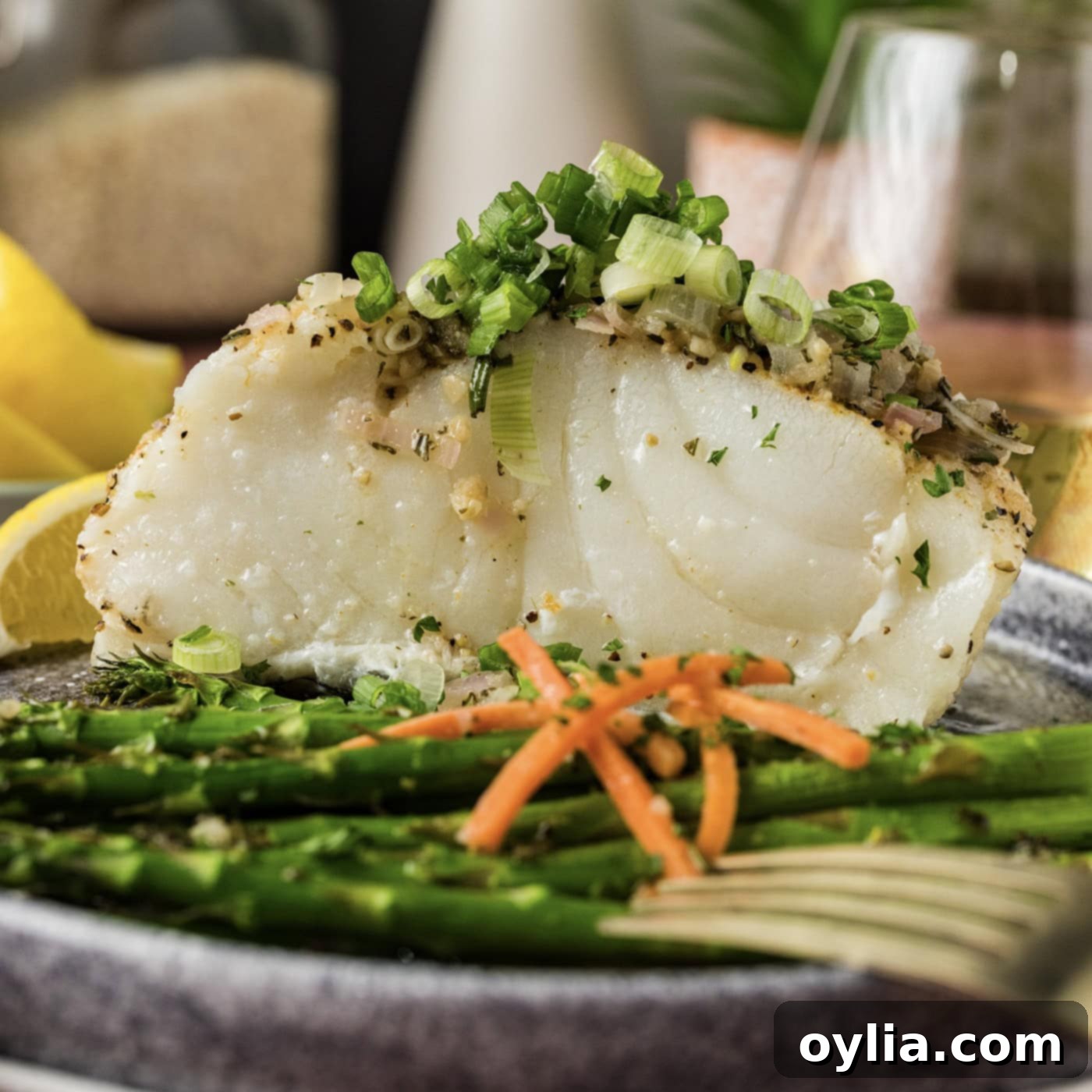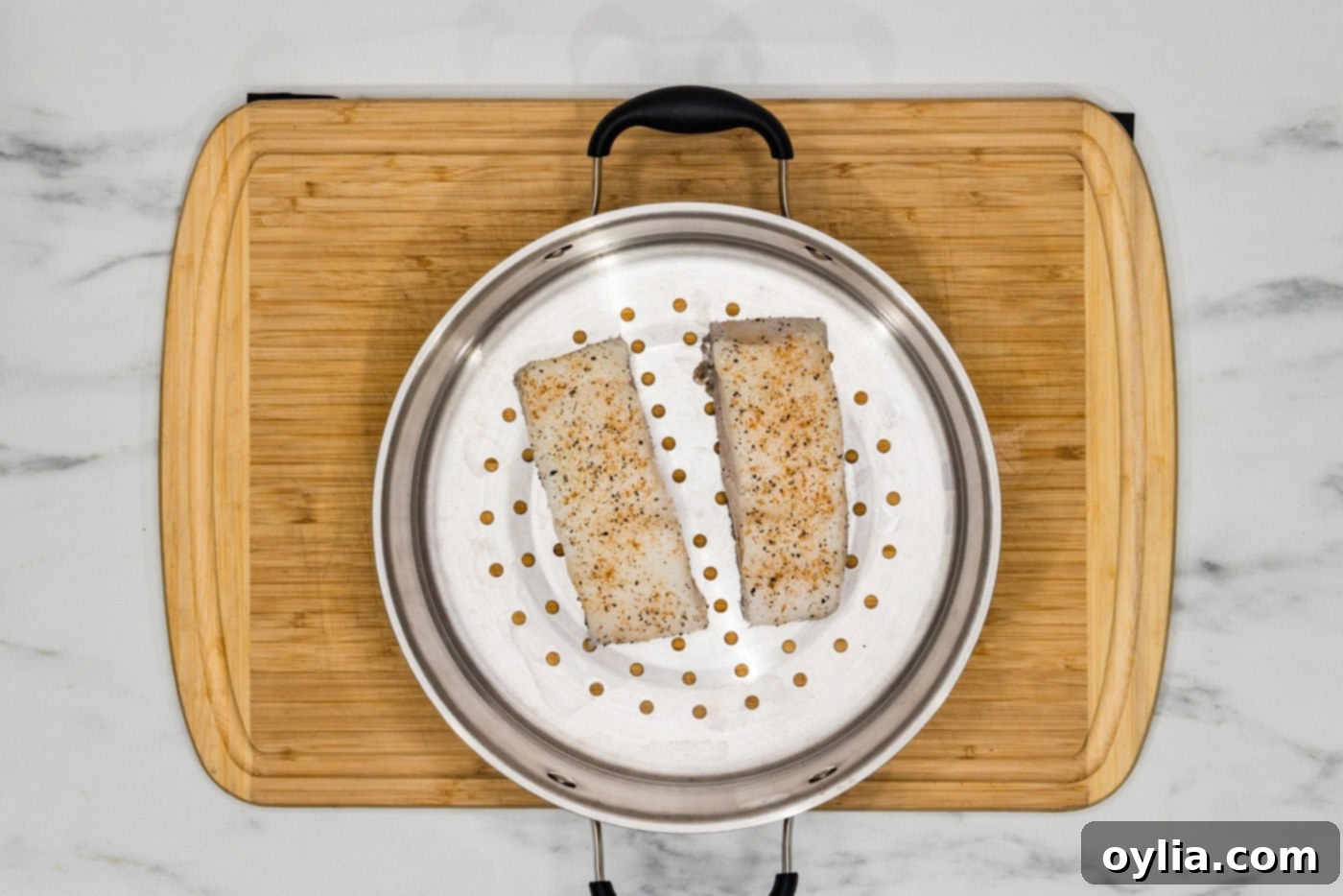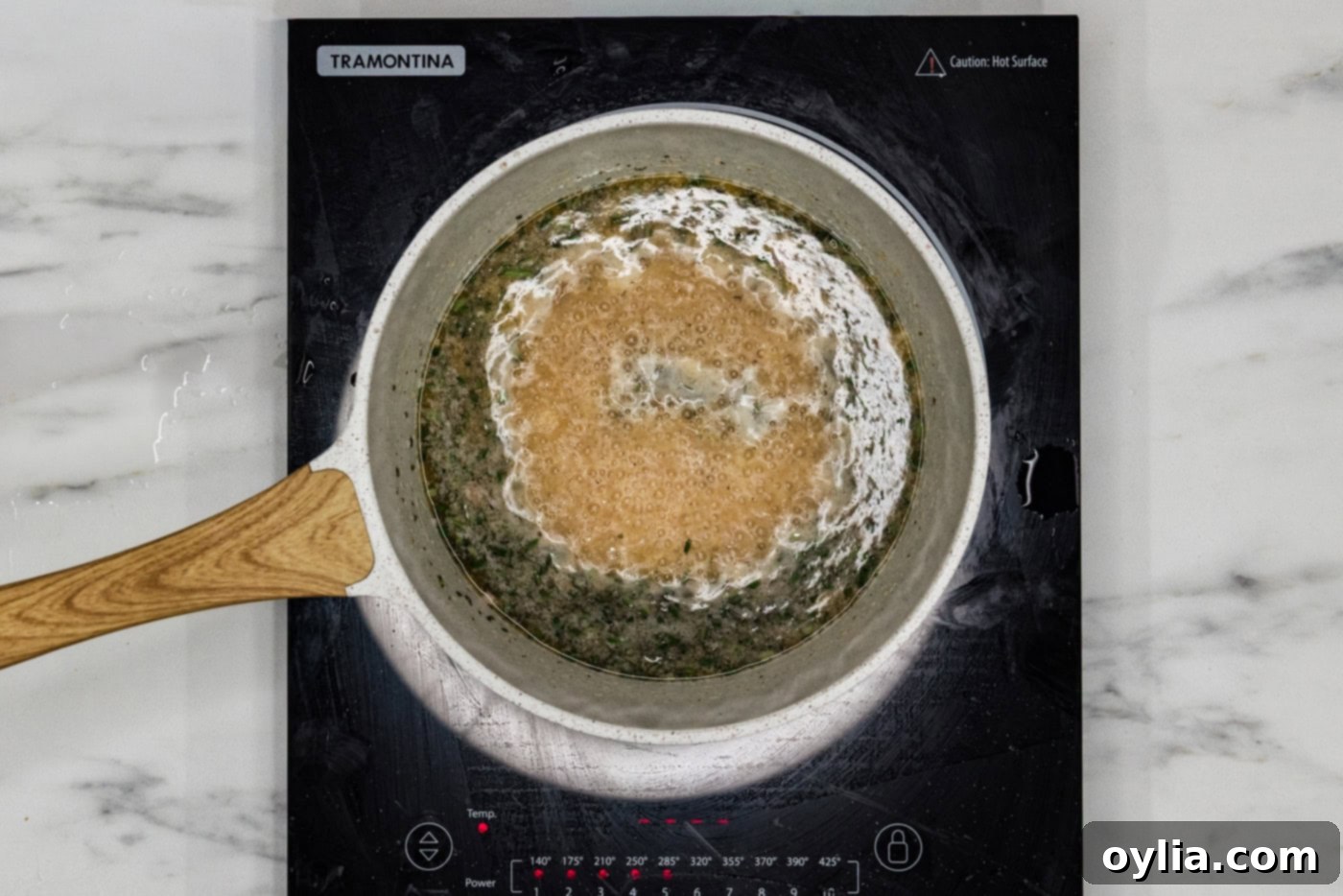Easy Steamed Chilean Sea Bass with Lemon-Herb White Wine Sauce
Indulge in an exquisite dining experience with this incredibly simple yet elegant Steamed Chilean Sea Bass recipe. In just 25 minutes, you can transform delicate Chilean sea bass fillets into a melt-in-your-mouth tender masterpiece, perfectly complemented by a luscious lemon-herb white wine sauce. Steaming is a phenomenal cooking method that preserves the fish’s natural moisture and highlights its rich, buttery flavor, making it an ideal choice for this premium seafood. Whether you’re a seasoned chef or a home cook seeking a quick gourmet meal, this recipe promises to impress with minimal effort and maximum flavor.

The Magic of Steaming: Why This Recipe Shines
This steamed Chilean sea bass recipe truly stands out because steaming is arguably one of the best ways to prepare this magnificent fish. Chilean sea bass, also known as Patagonian Toothfish, is renowned for its incredibly rich, buttery, and flaky texture. Its delicate nature demands a cooking method that respects its inherent qualities, and steaming does precisely that. Unlike pan-searing, baking, or grilling, which can introduce browning, charring, or additional oils that might mask its natural taste, steaming gently cooks the fish. This method ensures that every succulent bite retains its moisture, leading to a truly melt-in-your-mouth experience where the fish’s exquisite natural flavors are the star of the show.
While there are numerous fantastic ways to cook Chilean sea bass – you can bake it, roast it, or pan-sear it – each technique imparts a unique flavor profile. For instance, my husband, Chef Antoine, absolutely adores Chilean sea bass and we prepare it at least once a month, constantly experimenting with different preparations. While grilled Chilean sea bass is a favorite for its hearty texture and smoky char, steaming offers an unparalleled purity. It’s perfect for those evenings when you crave a lighter, healthier meal that still feels incredibly luxurious and satisfying. The gentle moist heat prevents drying, resulting in a tender, flaky fillet every time, which is then elevated by a vibrant and aromatic white wine sauce that complements the fish without overpowering it.
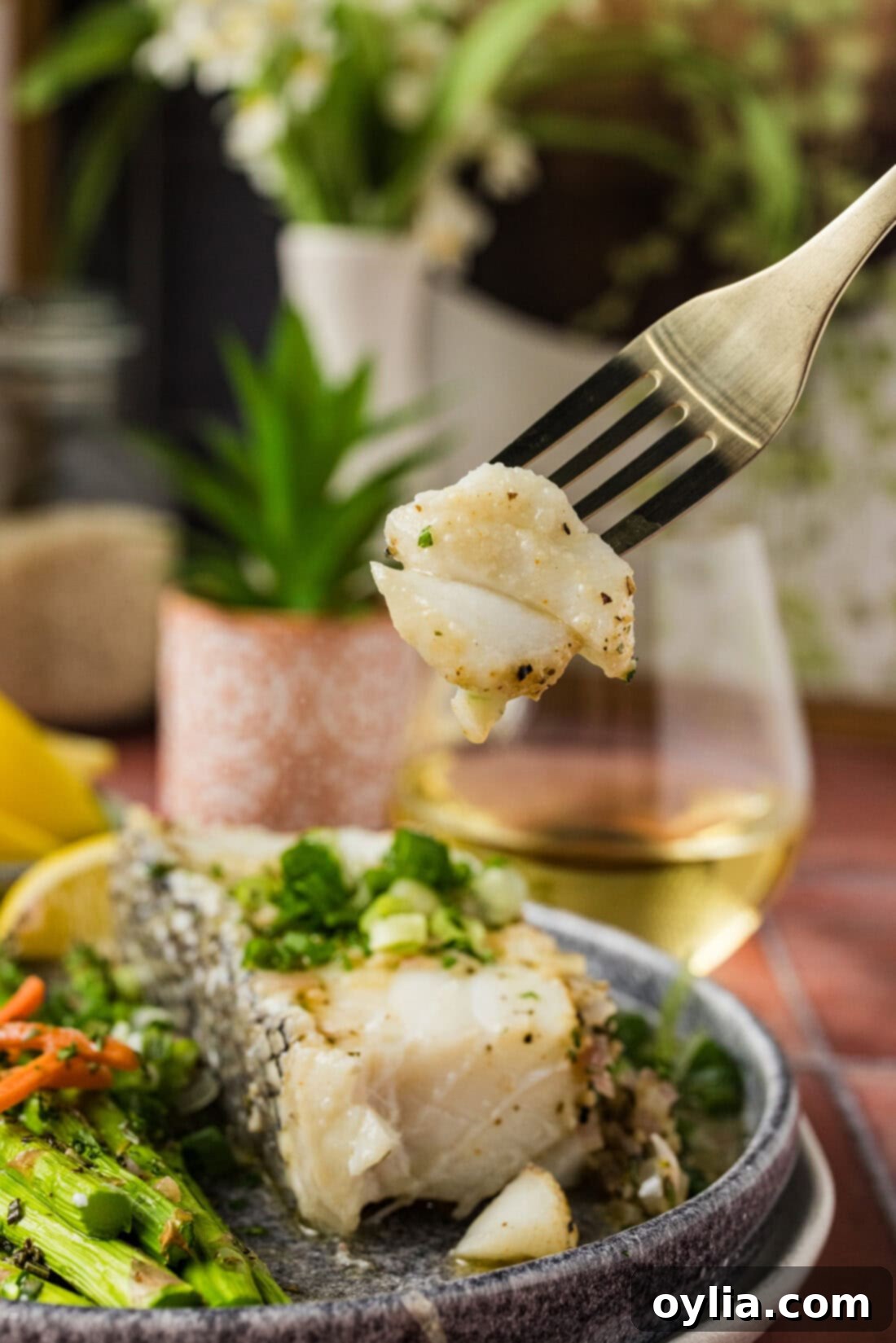
Gather Your Ingredients for a Gourmet Meal
Crafting this elegant dish requires a few key, high-quality ingredients that work in harmony to create a truly memorable meal. Freshness is paramount, especially when it comes to seafood, so always opt for the best quality Chilean sea bass you can find. The beauty of this recipe lies in its simplicity, allowing each component to shine. All precise measurements, detailed ingredients, and step-by-step instructions are available in the printable recipe card located conveniently at the end of this post, ensuring you have everything you need at your fingertips to recreate this delightful dish.
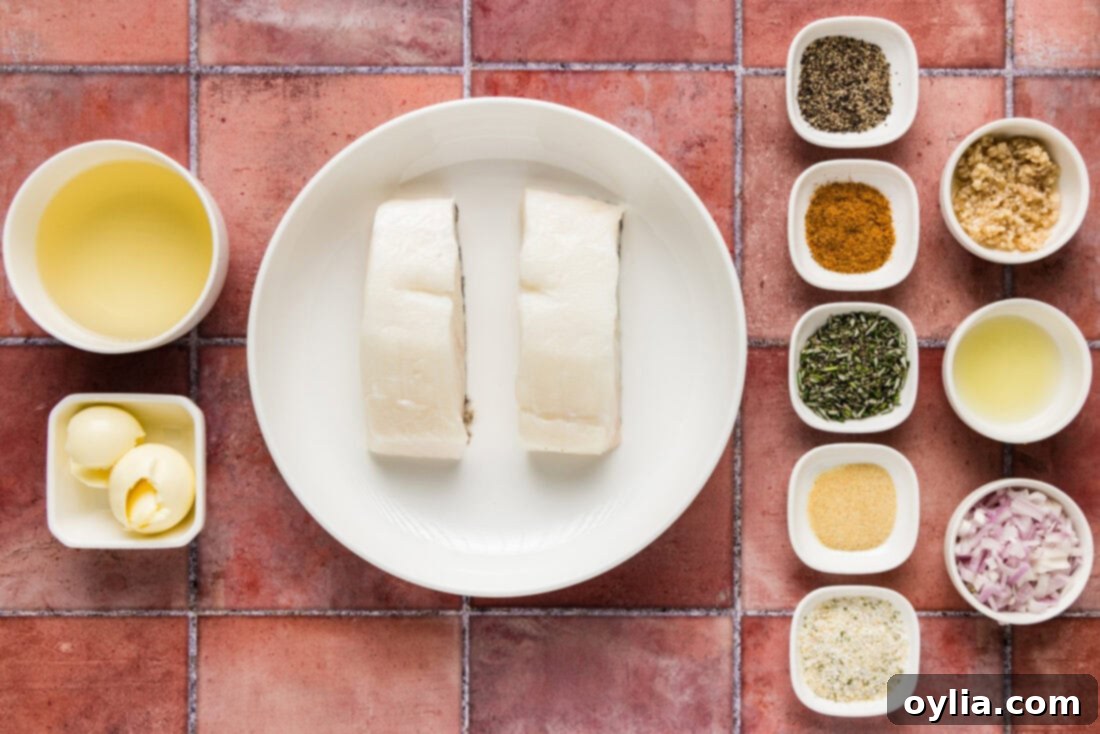
Essential Ingredient Insights and Smart Substitutions
FISH SELECTION: When purchasing Chilean sea bass (Patagonian Toothfish), your choice of cut can significantly impact the final texture and enjoyment of your dish. We highly recommend opting for the **center cut** portions. These thicker fillets are prized for their consistent, buttery consistency and are generally less bony. The tail end of the fish tends to be flakier and, as mentioned, can contain more small bones, which might detract from the luxurious experience. Look for fillets that are opaque, moist, and free from any strong fishy odor, indicating freshness. If you’re concerned about sustainability, seek out responsibly sourced Chilean sea bass from reputable fishmongers.
THE SAUCE: Our exquisite sauce relies on a dry white wine to infuse a delicate acidity and depth of flavor that beautifully complements the richness of the sea bass. Varietals like Sauvignon Blanc, Pinot Grigio, or even a dry Chardonnay work wonderfully. The alcohol cooks off during preparation, leaving behind a sophisticated taste. However, if you prefer a non-alcoholic option or don’t have white wine on hand, you can confidently substitute it with an equal amount of good quality chicken stock or vegetable broth. While the flavor profile will shift slightly, it will still yield a delicious, savory sauce. For a similar acidic brightness without alcohol, a splash of white grape juice with a tiny bit of white vinegar could also be considered, though chicken stock remains the best non-alcoholic alternative.
SEASONINGS: The choice of seasonings for both the fish and the sauce is designed to enhance rather than overwhelm. Garlic salt, black pepper, and Old Bay seasoning are classic seafood companions. Garlic salt provides a foundational savory note, while fresh cracked black pepper adds a subtle warmth. Old Bay, with its unique blend of spices, offers that quintessential “seafood boil” aroma and a hint of zesty spice, making it perfect for elevating the fish’s natural sweetness. For the sauce, fresh lemon juice adds a crucial bright counterpoint to the butter and wine, while finely chopped shallots bring a gentle, aromatic sweetness. Fresh rosemary sprigs are key for imparting an earthy, fragrant note that elevates the entire dish.
Crafting Your Steamed Chilean Sea Bass: Step-by-Step Guide
These step-by-step photos and detailed instructions are provided to help you visualize each stage of preparing this recipe, ensuring a perfect outcome. For your convenience, you can skip directly to the Jump to Recipe section to access the full printable version of this recipe, complete with precise measurements and instructions at the bottom of the page.
- Begin by setting up your steaming equipment. Add approximately 2 inches of water to the bottom of your steam pot. Place it over medium-high heat and bring the water to a vigorous, rolling boil. Ensure there’s enough water to generate steam for 8-10 minutes without boiling dry, but not so much that it touches the bottom of your steamer basket.
- While the water is heating, prepare your Chilean sea bass. If you have a larger piece of fish, cut it into two manageable fillets for easier handling and more even steaming. Season both sides of the fish generously (to your taste preferences) with garlic salt, freshly ground black pepper, and Old Bay seasoning. This delicate blend will enhance the fish’s natural flavors without overpowering them. Carefully place the seasoned fish into your steamer basket. Once the water in the pot is boiling steadily, reduce the heat to medium to maintain a constant, gentle steam. Place the steamer basket securely over the boiling water, then cover it tightly with a lid to trap the steam effectively.

- Allow the fish to steam for 8-10 minutes. The exact cooking time may vary slightly depending on the thickness of your fillets. The fish is cooked when it flakes easily with a fork and reaches an internal temperature of 140°F (60°C). Overcooking will dry out the delicate fish, so keep a close eye on it.
- Meanwhile, as your fish is steaming, prepare the exquisite white wine sauce. In a medium saucepan, combine all the sauce ingredients: butter, chopped shallots, fresh lemon juice, Old Bay seasoning, black pepper, garlic salt, dry white wine, onion powder, and chopped rosemary leaves. Bring this mixture to a boil over medium-high heat, then immediately reduce the heat to medium and let it simmer gently. Continue cooking the sauce until the fish is done, allowing the flavors to meld and the sauce to thicken slightly to a beautiful, brothy consistency. This timing ensures both components are ready simultaneously for optimal freshness and temperature.

Frequently Asked Questions & Expert Tips for Perfect Steamed Sea Bass
For perfectly cooked, moist, and tender Chilean sea bass, it should reach an internal temperature of 140°F (60°C). You can accurately check this by inserting an instant-read thermometer into the thickest portion of the fish fillet. It’s crucial not to overcook, as Chilean sea bass can quickly dry out and lose its signature buttery texture.
Any leftover steamed Chilean sea bass should be stored promptly in an airtight container and kept refrigerated. It will remain fresh for up to 3 days. To reheat, the best method is to gently steam it again for about 4 minutes, or until it is thoroughly warmed through. This helps to preserve its moisture and delicate texture. Alternatively, you can preheat your oven to a low temperature of 275°F (135°C). Place the fish in a foil-covered baking dish with a small splash of water or broth to create a steamy environment and prevent it from drying out. Heat for approximately 10-15 minutes, or until heated through. Avoid using a microwave if possible, as it can quickly rubberize fish.
Don’t Overcrowd the Steamer: Ensure there’s ample space between your fish fillets in the steamer basket. This allows steam to circulate evenly, ensuring all pieces cook at the same rate. If you have too much fish, steam it in batches. Use Fresh Herbs: Fresh rosemary is recommended for the sauce, but you can also place a few sprigs or slices of lemon directly in the steamer basket with the fish for added aromatic infusion. Monitor Cooking Time Closely: Chilean sea bass cooks quickly. Start checking for doneness at the lower end of the recommended time to prevent overcooking. The fish should be opaque and flake easily. Season Generously: While steaming preserves natural flavors, a good baseline of seasoning like garlic salt, pepper, and Old Bay enhances the experience significantly. Taste and adjust seasonings in the sauce as you go.

Elevate Your Meal: Delicious Serving Suggestions
Once your perfectly steamed Chilean sea bass is ready, it’s time to assemble an unforgettable meal. The rich, buttery fish paired with the vibrant white wine sauce is a star in its own right, but a well-chosen side dish can complete the experience. Consider serving your elegant fish with a medley of simple yet flavorful accompaniments such as roasted or steamed asparagus, creamy mashed potatoes, tender green beans, or crisp broccoli. For a lighter touch, a side of fluffy quinoa or a fresh garden salad would be excellent choices. Personally, I love to add a final squeeze of fresh lemon juice over the fish just before serving; the bright acidity truly makes all the flavors pop. Garnish with a sprinkle of fresh parsley or dill for an added touch of color and aroma. For a complete dining experience, pair this dish with a crisp, dry white wine like the one used in the sauce, such as Sauvignon Blanc or Pinot Grigio. Enjoy every exquisite bite!
Discover More Delicate Seafood Recipes
If you loved this steamed Chilean sea bass, you might enjoy exploring other delicious and easy seafood recipes that highlight the natural flavors of the ocean:
- Poached Salmon
- Grilled Mahi Mahi
- Baked Chilean Sea Bass
- Baked Orange Roughy
I’m passionate about baking and cooking, and I absolutely love sharing my kitchen adventures and delicious creations with all of you! Remembering to come back each day for new recipes can be tricky, which is why I offer a convenient newsletter every time a new recipe is posted. Simply subscribe today and start receiving your free daily recipes directly in your inbox!

Steamed Chilean Sea Bass
IMPORTANT – There are often Frequently Asked Questions within the blog post that you may find helpful. Simply scroll back up to read them!
Print It
Pin It
Rate It
Save ItSaved!
Ingredients
- 1 pound Chilean sea bass cut into 2 filets
- garlic salt to taste
- black pepper to taste
- Old Bay seasoning to taste
Sauce
- 2 Tablespoons butter
- ¼ cup chopped shallots
- 1 Tablespoon fresh lemon juice
- ¼ teaspoon Old Bay seasoning
- ⅛ teaspoon black pepper
- ¼ teaspoon garlic salt
- ½ cup dry white wine
- 1 teaspoon onion powder
- 1 teaspoon chopped rosemary leaves
Things You’ll Need
-
Steam pot
-
Saucepan
-
Whisk
Before You Begin
- Chilean sea bass should reach an internal temperature of 140°F (60°C) registered on an instant-read thermometer inserted into the thickest portion of the fish.
- When choosing Chilean sea bass, opt for the center cut. The tail end of the fish will be flakier but also bonier. The center-cut portions are thick and have a buttery consistency, ideal for steaming.
- We use dry white wine in the sauce for this recipe to add a bright, acidic counterpoint. You can substitute with chicken stock or vegetable broth if you prefer a non-alcoholic option.
Instructions
-
Add about 2 inches of water to the bottom of the steam pot and bring to a rolling boil over medium-high heat.
-
If needed, cut the fish into two uniform filets to ensure even cooking. Season generously to taste with garlic salt, black pepper, and Old Bay seasoning. Place the seasoned fish into the steamer basket. Once the water is boiling, reduce the heat to medium, place the steamer basket in position, and cover tightly with the lid.1 pound Chilean sea bass
-
Steam the fish for 8-10 minutes, or until it is opaque and flakes easily with a fork, reaching an internal temperature of 140°F (60°C).
-
Concurrently, while the fish is steaming, prepare the flavorful sauce. In a medium saucepan, add all the specified sauce ingredients: butter, chopped shallots, fresh lemon juice, Old Bay seasoning, black pepper, garlic salt, dry white wine, onion powder, and chopped rosemary leaves. Bring the mixture to a boil, then reduce the heat to medium and simmer until the fish is cooked through. The sauce should be slightly thickened with a lovely brothy consistency.2 Tablespoons butter, 1/4 cup chopped shallots, 1 Tablespoon fresh lemon juice, 1/4 teaspoon Old Bay seasoning, 1/8 teaspoon black pepper, 1/4 teaspoon garlic salt, 1/2 cup dry white wine, 1 teaspoon onion powder, 1 teaspoon chopped rosemary leaves
Expert Tips & FAQs
- Leftover Chilean sea bass can be stored in an air-tight container in the refrigerator for up to 3 days. To gently reheat and maintain its delicate texture, it’s best to steam it again for about 4 minutes or until warmed through. Alternatively, warm your oven to 275°F (135°C). Place the fish in a foil-covered baking dish with a small splash of water or broth to ensure it remains moist, and heat for about 10-15 minutes or until fully heated through.
- Always aim for consistency in fillet thickness. If your fish pieces vary significantly, you might need to adjust steaming times or consider butterflying thicker pieces slightly to achieve a more uniform cook.
- For an extra layer of flavor, consider adding a few slices of lemon or a sprig of fresh herbs like dill or parsley to the steamer basket alongside the fish. This subtly infuses the fish with additional aroma as it cooks.
Nutrition
The recipes on this blog are tested with a conventional gas oven and gas stovetop. It’s important to note that some ovens, especially as they age, can cook and bake inconsistently. Using an inexpensive oven thermometer can assure you that your oven is truly heating to the proper temperature. If you use a toaster oven or countertop oven, please keep in mind that they may not distribute heat the same as a conventional full sized oven and you may need to adjust your cooking/baking times. In the case of recipes made with a pressure cooker, air fryer, slow cooker, or other appliance, a link to the appliances we use is listed within each respective recipe. For baking recipes where measurements are given by weight, please note that results may not be the same if cups are used instead, and we can’t guarantee success with that method.
